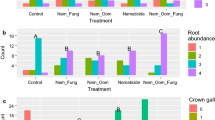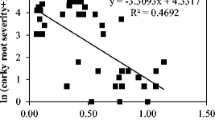Abstract
Aims
A study on the effectiveness of replanting in “inter-row” to minimize replant disease in apple orchards was performed focusing on the plant-microorganism relationship.
Methods
Simulation of a post transplant period with M9 rootstock plantlets was performed in soil samples taken from five third-generation orchards. Plant growth and root health, root colonizing fungi and bacteria of rhizospheric soil were evaluated at the end of the post-transplant simulation.
Results
Plant growth did not differ across the orchards, but was highest (P > 0.01) in the “inter-row”. Root colonizing fungi composition differed from one orchard to the other, but not between row and inter-row. Fusarium solani and F. oxysporum were the most represented species followed by Cylindrocarpon spp, binucleate Rhizoctonia sp., and Fusarium spp. Cylindrocarpon spp and binucleate Rhizoctonia sp. were pathogenic and occurred everywhere. Rhizosphere bacteria differed across orchards, but their position within the orchards did not. As plant growth response to the row and inter-row varied through the orchards, findings suggest that microbial interaction and pathogen host specificity play a role in plant health.
Conclusions
Replanting in inter-row can minimize replant disease but potential fungal pathogens are endemic in soil, therefore replanting should be associated with strategies increasing soil suppressiveness in established orchards.








Similar content being viewed by others
References
Alloway BJ (1999) Heavy Metals in Soils. Halsted, New York
Bacon CW, Yates CE (2006) Endophytic root colonization by Fusarium species. In: Schulz BJE, Boyle CJC, Sieber TN (eds) Microbial root endophytes pp 133–152 Springer
Braun GP (1995) Effects of Cylindrocarpon and Pythium species on apple seedlings and potential role in apple replant disease. Can J Plant Pathol 17:336–341. doi:10.1080/07060669509500672
Braun GP, Fuller KD, McRae K, Fillmore SAE (2010) Response of ‘Honeycrisp®’ apple trees to combinations of pre-plant fumigation, deep ripping, and hog manure compost incorporation in a soil with replant disease. HortSci 45:1702–1707
Bray JR, Curtis JT (1957) An ordination of the upland forest communities of southern Wisconsin. Ecol Monogr 27:326–349
Browne GT, Connell JH, Schneider SM (2006) Almond replant disease and its management with alternative pre-plant soil fumigation treatments and rootstocks. Plant Dis 90:869–876. doi:10.1094/PD-90-0869
Ciavatta C, Vittori Antisari L, Sequi P (1989) Determination of organic carbon in soils and fertilizers. Commun Soil Sci Plant Anal 20:759–773
Commonwealth Agricultural Bureau (CAB) (1990) Description of pathogenic fungi and bacteria. N.1-1000 from January 1964 to March 1990. CAB International Mycological Institute. Kluwer Acc Pub
Cooke BM (1998) Disease assessment and yield losses cap 3, pp 42–68. In: Gareth Jones B (ed) The epidemiology of plant diseases, Kluwer Accademic publisher
Dell’Amico E, Mazzocchia M, Cavalca L, Allievi L, Andreoni V (2008) Assessment of bacterial community structure in a long-term copper-polluted ex-vineyard soil. Microbiol Res 163:671–683. doi:10.1016/j.micres.2006.09.003
Diaz J, Silvar C, Varela MM, Bernal A, Merino F (2005) Fusarium confers protection against several mycelial pathogens of pepper plants. Plant Pathol 54:773–780. doi:10.1111/j.1365-3059.2005.01285.x
Ellis MB (1971) Dematiaceous Hyphomycetes CABI intern. Kew, Surrey, p 608
Emery KM, Beuselinck PR, English JT (2003) Genetic diversity and virulence of Rhizoctonia species associated with plantings of Lotus corniculatus. Mycol Res 107:183–189. doi:10.1017/S0953756202007074
Fantroussi SIE, Verschuere L, Verstraete W, Eva M (1999) Effect of phenylurea herbicides on soil microbial communities estimated by analysis of 16S rRNA gene fingerprints and community-level physiological profiles. Appl Environ Microbiol 65:982–988
Forge TA, Hogue E, Neilsen G, Neilsen D (2003) Effects of organic mulches on soil microfauna in the root zone of apple: implications for nutrient fluxes and functional diversity of the soil food web. Appl Soil Ecol 22:39–54. doi:10.1016/S0929-1393(02)00111-7
Gur A, Cohen Y, Katan J, Barkai Z (1991) Preplant application of soil fumigants and solarization for treating replant diseases of peaches and apples. Sci Hort 45:215–224
Haichar FeZ, Marol C, Berge O, Rangel-Castro JI, Prosser JI, Balesdent J, Heulin T, Achouak W (2008) Plant host habitat and root exudates shape soil bacterial community structure. ISME J 2:1221–1230. doi:10.1038/ismej.2008.80
Hammer Ø, Harper DAT, Ryan PD (2001) PAST: paleontological statistics software package for education and data analysis. Palaeont Electr 4(1):9
Herre EA, Mejía LC, Kyllo DA, Rojas E, Maynard Z, Butler A, Van Bael SA (2007) Ecological implications of anti-pathogen effects of tropical fungal endophytes and mycorrhizae. Ecology 88:550–558. doi:10.1890/05-1606
Hoffmann G (1997) Methodenbuch, Band 1, Die Untersuchung von Böden, vierte Auflage,1. Teillieferung, 2. Teillieferung 1997. VDLUFA-Verlag, Bonn
Jaffee BA, Abawi GS, Mai WF (1982) Fungi associated with replant seedlings grown in soil from apple replant site. Plant Dis 66:42–944
Kernaghan G, Patriquin G (2010) Host associations between fungal root endophytes and boreal trees. Microb Ecol 62:460–473. doi:10.1007/s00248-011-9851-6
Kozdrój J, van Elsas JD (2000) Response of the bacterial community to root exudates in soil polluted with heavy metals assessed by molecular and cultural approaches. J Soil Biol Biochem 32:1405–1417. doi:10.1016/S0038-0717(00)00058-4
Kronald WC, Stanghellini ME (1988) Clean slide technique for the observation of anastomosis and nuclear condition in Rhizoctonia solani. Phytopathology 78:820–822
Lehtonen MJ, Ahvenniemi P, Wilson PS, German-Kinnari M, Valkonen JPT (2008) Biological diversity of Rhizoctonia solani (AG-3) in a northern potato-cultivation environment in Finland. Plant Pathol 57:141–151. doi:10.1111/j.1365-3059.2007.01694.x
Leinfelder MM, Merwin IA (2006) Rootstock selection, preplant soil treatments, and tree planting positions as factors in managing apple replant disease. HortSci 41:394–401
Lewis DH (1985) Symbiosis and mutualism: crisp concepts and soggy semantics. In: Boucher DH (ed) The biology of mutualism. Croom-Helm Ltd., London, pp 29–39
Lockwood JL (1988) Evolution of concepts associated with soilborne plant pathogens. Annu Rev Phytopathol 26:93–121
Maciá-Vicente JG, Jansson H-B, Abdullah SK, Descals E, Salinas J, Lopez-Llorca LV (2008) Fungal root endophytes from natural vegetation in Mediterranean environments with special reference to Fusarium spp. FEMS Microbiol Ecol 64:90–105. doi:10.1111/j.1574-6941.2007.00443.x
Mai WF, Abawi GS (1981) Controlling replant disease of pome and stone fruit in northern United States by preplant fumigation. Plant Dis 65:859–864
Manici LM, Bonora P (2007) Molecular genetic variability of Italian binucleate Rhizoctonia spp. isolates from strawberry. Eur J Plant Pathol 118:31–42. doi:10.1007/s10658-007-9100-5
Manici LM, Caputo F (2010) Soil fungal communities as indicators for replanting new peach orchards in intensively cultivated areas. Eur J Agron 33:188–196. doi:10.1016/j.eja.2010.05.005
Manici LM, Ciavatta C, Kelderer M, Erschbaumer G (2003) Replant problems in South Tyrol: role of fungal pathogens and microbial populations in conventional and organic apple orchards. Plant Soil 256:315–324. doi:10.1023/A:1026103001592
Mazzola M (1997) Identification and pathogenicity of Rhizoctonia spp. isolated from apple roots and orchard soils. Phytopathology 87:582–587. doi:10.1007/s10658-007-9100-5
Mazzola M (1998) Elucidation of the microbial complex having a causal role in the development of apple replant disease in Washington. Phytopathology 88:930–938. doi:10.1094/PHYTO.1998.88.9.930
Mazzola M (1999) Transformation of soil microbial community structure and Rhizoctonia-suppressive potential in response to apple roots. Phytopathology 89:920–927. doi:10.1094/PHYTO.1999.89.10.920
Mazzola M, Gu Y-H (2002) Wheat genotype-specific induction of soil microbial communities suppressive to disease incited by Rhizoctonia solani anastomosis group (AG)-5 and AG-8. Phytopathology 92:1300–1307. doi:10.1094/PHYTO.2002.92.12.1300
Muyzer G, de Waal EC, Uitterlinden A (1993) Profiling of complex microbial populations using denaturing gradient gel electrophoresis analysis of polymerase chain reaction-amplified genes coding for 16S rRNA. Appl Environ Microbiol 59:695–700
Nelson PE, Tousson TA, Marasas WFO (1983) Fusarium species. An illustrated manual for identification. The Pennsylvania State University Press, Pennsylvania, p 190
O’Brien RD, van Bruggen AHC (1992) Accuracy, precision, and correlation to yield loss of disease severity scales for corky root of lettuce. Phytopathology 82:91–96
Pitcher RS, Way DW, Savory BM (1966) Specific replant diseases of apple and cherry and their control by soil fumigation. J Hort Sci 41:379–396
Redman RS, Dunigan DD, Rodriguez RJ (2001) Fungal symbiosis from mutualism to parasitism: who controls the outcome, host or invader? New Phytol 151:705–716
Samson RA, van Reenen-Hoekstra ES (1988) Introduction to food-borne pathogens 3rd edition. Baarn and Delft Centraalbureau vor Schimmelcultures, 299 pp
Savory BM (1966) Specific replant diseases causing root necrosis and growth depression in perennial fruit and plantation crops. Research Rev Commonw Bur Horth Pl Crops 64 pp
Savory BM (1969) Evidence that toxins are not the causal factors of the specific apple replant disease. Ann Appl Biol 63:225–323
Tewoldemedhin Y, Mazzola M, Mostert L, McLeod A (2011a) Cylindrocarpon species associated with apple tree roots in South Africa and their quantification using real-time PCR. Eur J Plant Pathol 129:637–651. doi:10.1007/s10658-010-9728-4
Tewoldemedhin YT, Mazzola M, Botha WJ, Spies CFJ, McLeod A (2011b) Characterization of fungi (Fusarium and Rhizoctonia) and oomycetes (Phytophthora and Pythium) associated with apple orchards in South Africa. Eur J Plant Pathol 130:215–229. doi:10.1007/s10658-011-9747-9
Tewoldemedhin YT, Mazzola M, Labuschagne I, McLeod A (2011c) A multi-phasic approach reveals that apple replant disease is caused by multiple biological agents, with some agents acting synergistically. Soil Biol Biochem 43:1917–1927. doi:10.1016/j.soilbio.2011.05.014
Tom-Petersen A, Leser TD, Marsh TL, Nybroe O (2003) Effects of copper amendment on the bacterial community in agricultural soil analyzed by the T- RFLP technique. FEMS Microbiol Ecol 46:42–53. doi:10.1016/S0168-6496(03)00192-2
Utkhede RS, Li TSC (1988) Determining the occurrence of replant disease in British Columbia orchard and vineyard soils by pasteurization Can. Plant Dis Surv 68:149–151
van Bruggen AHC, Semenov A, van Diepeningen AD, de Vos OJ, Blok WJ (2006) Relation between soil health, wave-like fluctuations in microbial populations and soil borne plant disease management. Eur J Plant Pathol 115:105–122. doi:10.1007/s10658-005-1250-8
Watanabe T (2002). Soil and seed fungi 2° ed, CRC press 486 pp
Wilson S, Andrews P, Nair TS (2004) Non-fumigant management of apple replant disease. Sci Hort 102:221–231. doi:10.1016/j.scienta.2004.01.001
Winding A, Nielsen MN (2002) Microorganisms as indicators of soil health. NERI Technical Report No. 388. 82 pp http://www2.dmu.dk/1_viden/2_publikationer/3_fagrapporter/rapporter/FR388.pdf
Yao S, Merwin IA, Bird GW, Abawi GS, Thies JE (2005) Orchard floor management practices that maintain vegetative or biomass groundcover stimulate soil microbial activity and alter soil microbial community composition. Plant Soil 271:377–389. doi:10.1007/s11104-004-3610-0
Acknowledgements
The authors would like to thank A. Lazzari at the laboratory of mycology at CRA-CIN; and E. Lardschneider and A. R Topp in trials at the Laimburg Research Station, for their technical support.
Study funded by the Italian Ministry of Politics for Agriculture, Food and Forestry (Mi.P.A.A.F.) through the project ENDOBIOFRUT.
Author information
Authors and Affiliations
Corresponding author
Additional information
Responsible Editor: Peter A.H. Bakker.
Rights and permissions
About this article
Cite this article
Kelderer, M., Manici, L.M., Caputo, F. et al. Planting in the ‘inter-row’ to overcome replant disease in apple orchards: a study on the effectiveness of the practice based on microbial indicators. Plant Soil 357, 381–393 (2012). https://doi.org/10.1007/s11104-012-1172-0
Received:
Accepted:
Published:
Issue Date:
DOI: https://doi.org/10.1007/s11104-012-1172-0




